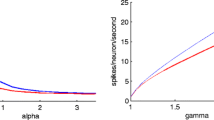Summary
-
1.
The assumption that the negative extracellular population spikes recorded from the pyramidal or granular layers in the hippocampal formation in response to appropriate afferent volleys is due to the sum of individual unitary discharges was tested by recording unit activity and population spike with microelectrodes, using normal and ultrashort amplifier time constants.
-
2.
Unit spikes were correlated in time with the population spike.
-
3.
The size of the population spike was altered by varying the stimulus strength, or by using a conditioning-test technique. In either case the number of units recorded followed the change in the size of the population spike. For very large population spikes, the technique failed since unit spikes could then no longer be clearly distinguished.
-
4.
The theoretically expected shape of the population spike as a summation of individual unit discharges was derived, and discussed in terms of the observed results.
-
5.
We conclude that over a wide range the height of the population spike is an increasing function of the number of discharging cells and can thus be used as a measure of the extent to which an afferent volley discharges a cell population.
Similar content being viewed by others
References
Andersen, P., Bliss, T.V.P., Skrede, K.K.: Lamellar organization of hippocampal excitatory pathways. Exp. Brain Res. 13, 222–238 (1971).
—, Eccles, J.C., Løyning, Y.: Location of postsynaptic inhibitory synapses on hippocampal pyramids. J. Neurophysiol. 27, 592–607 (1964a).
—: Pathway of postsynaptic inhibition in the hippocampus. J. Neurophysiol. 27, 608–619 (1964b).
—, Holmqvist, B., Voorhoeve, P.E.: Excitatory synapses on hippocampal apical dendrites activated by entorhinal stimulation. Acta physiol. scand. 66, 461–472 (1966).
Blackstad, T.W.: Comments on the connections of the fascia dentata, pp. 171–174. In: P. Andersen and J.K.S. Jansen (eds.): Excitatory Synaptic Mechanisms, 354 pp. Oslo: Universitetsforlaget 1970.
Eccles, J.C., Ito, M., Szentágothai, J.: The cerebellum as a neuronal machine, 335 pp. Berlin-Heidelberg-New York: Springer 1967.
Erlanger, J., Gasser, H.S.: The action potential in fibres of slow conduction in spinal roots and somatic nerves. Amer. J. Physiol. 92, 43–82 (1930).
Freygang, W.H., jr., Frank, K.: Extracellular potentials from single spinal motoneurons. J. gen. Physiol. 42, 749–760 (1959).
Geselowitz, D.B.: On bioelectric potentials in an inhomogeneous volume conductor. Biophys. J. 7, 1–11 (1967).
Humphrey, D.R.: Re-analysis of the antidromic cortical response. II. On the contribution of cell discharge and PSPs to the evoked potentials. Electroenceph. clin. Neurophysiol. 25, 421–442 (1968).
Kandel, E.R., Spencer, W.A.: Electrophysiology of hippocampal neurons. II. After-potentials and repetitive firing. J. Neurophysiol. 24, 243–259 (1961).
Katz, B.: Nerve, muscle and synapse, 193 pp. New York: McGraw-Hill Book Company 1966.
Lloyd, D.P.C.: A direct central inhibitory action of dromically conducted impulses. J. Neurophysiol. 4, 184–190 (1941).
Lorente de Nó, R.: Studies on the structure of the cerebral cortex. II. Continuation of the study of the Ammonic system. J. Psychol. Neurol. (Lpz.) 46, 113–177 (1934).
—: A study of nerve physiology. New York, The Rockefeller Institute for Medical Research, 2, 548 pp. (1947).
Lømo, T.: Patterns of activation in a monosynaptic cortical pathway: the perforant path input to the dentate area of the hippocampal formation. Exp. Brain Res. 12, 18–45 (1971a).
—: Potentiation of monosynaptic EPSPs in the perforant path — dentate granule cell synapse. Exp. Brain Res. 12, 46–63 (1971 b).
Rall, W., Shepherd, G.M.: Theoretical reconstruction of field potentials and dendrodendritic synaptic interactions in olfactory bulb. J. Neurophysiol. 31, 884–915 (1968).
Ramon y Cajal, S.: Histologie du système nerveux de l'Homme et des Vertébrés. Paris, A. Maloine, 2, 993 pp. (1911).
Renshaw, B.: Influence of discharge of motoneurons upon excitation of neighboring motoneurons. J. Neurophysiol. 4, 167–183 (1941).
Richards, C.D., Sercombe, R.: Electrical activity observed in guinea-pig olfactory cortex maintained in vitro. J. Physiol. (Lond.) 197, 667–683 (1968).
Author information
Authors and Affiliations
Additional information
On special leave of absence from the Medical Research Council.
Rights and permissions
About this article
Cite this article
Andersen, P., Bliss, T.V.P. & Skrede, K.K. Unit analysis of hippocampal population spikes. Exp Brain Res 13, 208–221 (1971). https://doi.org/10.1007/BF00234086
Received:
Issue Date:
DOI: https://doi.org/10.1007/BF00234086




